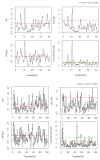Robust Wavelength Selection Using Filter-Wrapper Method and Input Scaling on Near Infrared Spectral Data
- PMID: 32899292
- PMCID: PMC7506801
- DOI: 10.3390/s20175001
Robust Wavelength Selection Using Filter-Wrapper Method and Input Scaling on Near Infrared Spectral Data
Abstract
The extraction of relevant wavelengths from a large dataset of Near Infrared Spectroscopy (NIRS) is a significant challenge in vibrational spectroscopy research. Nonetheless, this process allows the improvement in the chemical interpretability by emphasizing the chemical entities related to the chemical parameters of samples. With the complexity in the dataset, it may be possible that irrelevant wavelengths are still included in the multivariate calibration. This yields the computational process to become unnecessary complex and decreases the accuracy and robustness of the model. In multivariate analysis, Partial Least Square Regression (PLSR) is a method commonly used to build a predictive model from NIR spectral data. However, in the PLSR method and common commercial chemometrics software, there is no standard wavelength selection procedure applied to screen the irrelevant wavelengths. In this study, a new robust wavelength selection procedure called the modified VIP-MCUVE (mod-VIP-MCUVE) using Filter-Wrapper method and input scaling strategy is introduced. The proposed method combines the modified Variable Importance in Projection (VIP) and modified Monte Carlo Uninformative Variable Elimination (MCUVE) to calculate the scale matrix of the input variable. The modified VIP uses the orthogonal components of Partial Least Square (PLS) in investigating the informative variable in the model by applying the amount of variation both in X and y{SSX,SSY}, simultaneously. The modified MCUVE uses a robust reliability coefficient and a robust tolerance interval in the selection procedure. To evaluate the superiority of the proposed method, the classical VIP, MCUVE, and autoscaling procedure in classical PLSR were also included in the evaluation. Using artificial data with Monte Carlo simulation and NIR spectral data of oil palm (Elaeis guineensis Jacq.) fruit mesocarp, the study shows that the proposed method offers advantages to improve model interpretability, to be computationally extensive, and to produce better model accuracy.
Keywords: near infrared spectral data; partial least squares; robust statistics; scaling; uninformative variable eliminations; variable importance in projection; variable selection.
Conflict of interest statement
The authors declare no conflict of interest.
Figures











References
-
- Schowengerdt R.A. Remote Sensing Models and Methods for Image Processing. Academic Press; Cambridge, MA, USA: 1997.
-
- Hourant P., Baeten V., Morales M.T., Meurens M., Aparicio R. Oil and Fat Classification by Selected Bands of Near-Infrared Spectroscopy. Appl. Spectrosc. 2000;54:1168–1174. doi: 10.1366/0003702001950733. - DOI
-
- Kasemsumran S., Thanapase W., Punsuvon V., Ozaki Y. A Feasibility Study on Non-Destructive Determination of Oil Content in Palm Fruits by Visible–Near Infrared Spectroscopy. J. Near Infrared Spectrosc. 2012;20:687–694. doi: 10.1255/jnirs.1025. - DOI
-
- Chong I.-G., Jun C.-H. Performance of some variable selection methods when multicollinearity is present. Chemom. Intell. Lab. Syst. 2005;78:103–112. doi: 10.1016/j.chemolab.2004.12.011. - DOI
LinkOut - more resources
Full Text Sources
Miscellaneous

